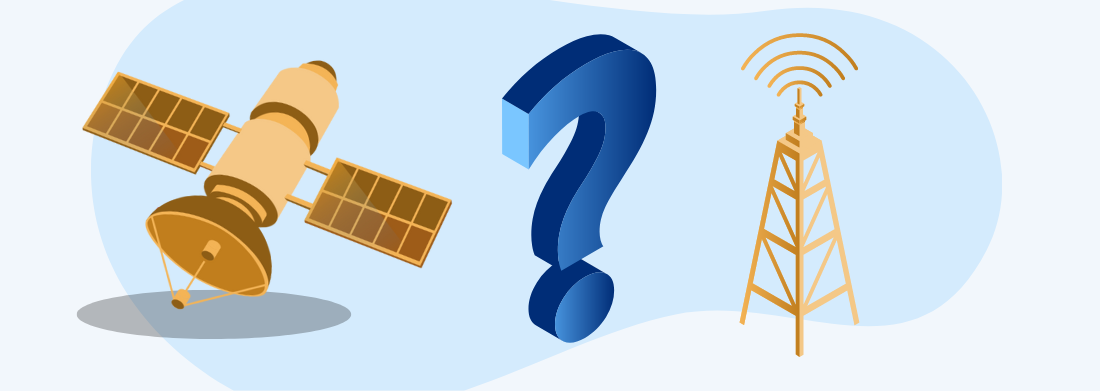DTH or Cable TV: What's Your Best Pick in India?

Picking the right TV service can be tricky, especially with so many options available. In India, two popular choices are Direct-to-Home (DTH) and Cable TV. It's like a battle between them to see which one is better. We're here to help you figure out which might be the best fit for your home. By the end, you'll have a better idea of which TV service suits your needs, budget, and how you like to watch TV. So, let's find out which one deserves the crown in your Indian living room!
Which DTH is Best: Choose the one that suit your requirements?
DTH Full Form: What is DTH?
DTH stands for Direct-to-Home, which is a digital satellite television broadcasting technology that allows users to receive television channels directly from satellites, rather than through cable or terrestrial networks. DTH is commonly used in areas where cable television services are not available or are of poor quality. With DTH, users can access a wide range of digital television channels with high-quality video and audio signals. The user needs a dish antenna, a set-top box, and a television set to receive DTH services.

DTH services are offered by various companies worldwide, including Dish TV, Tata Play DTH, Sun Direct DTH, and Airtel DTH, among others. These companies provide a variety of packages with different pricing and channel options to suit the needs and budget of different users.
Cable TV
Cable TV uses a network of cables to deliver television signals to households. The cable operator collects signals from various sources, such as broadcast stations, satellite feeds, and other sources, and then sends them through a network of cables to the user's TV set. The user needs a cable box and a television set to receive cable TV services.
The cable box is connected to the cable line, and the television is connected to the cable box. The user can then select the channels they want to watch and pay for a package that includes a specific set of channels. Cable TV services are offered by a lot of companies like: Hathway Cable TV, GTPL Cable TV and Den Cable TV.
Cable TV vs DTH
Cable TV and DTH (Direct-to-Home) are two popular television distribution systems. While cable TV relies on physical cables to transmit signals, DTH uses satellite technology to deliver programming directly to the viewer's dish antenna. Cable TV offers a wide range of channels and is often more affordable, while DTH provides better picture quality and signal reliability, along with the flexibility to choose specific channels or packages. Ultimately, the choice between cable TV and DTH depends on individual preferences and requirements. Here is a comparison table summarizing the differences between DTH and cable TV.
| Features | DTH | Cable TV |
|---|---|---|
| Delivery Method | Direct-to-Home satellite broadcasting technology | Broadcasting through a network of cables |
| Equipment | Dish antenna, set-top box or 4k set-top box and TV | Cable box and TV |
| Cost | Generally, more expensive | Generally, less expensive |
| Channel Selection | Wide range of channels, with the ability to select and pay for specific channels | Packages with specific sets of channels |
| Signal Quality | High-quality video and audio signals | May experience signal loss or degradation in bad weather or due to cable issues |
| Availability | Can be accessed in areas where cable or terrestrial TV services are not available | Limited availability in some areas |
Both technologies aim to provide entertainment to viewers, they differ in terms of their delivery method, pricing, and features. Along with both having their advantages and disadvantages, choosing between them can be a challenging task. In this article, we will explore the differences between DTH and cable TV to help you understand which option may be best for you.
DTH Set-Top Box vs Cable TV Set-Top Box

The entertainment industry has been evolving at an unprecedented pace, and the introduction of DTH Set-top Boxes and Cable TV Set-top Boxes has revolutionized the way people consume content. DTH HD Set-top Box and Cable TV Set-top Box are two popular options for accessing TV channels, movies, and other media content. While they may seem similar, there are significant differences between the two technologies. In this essay, we will explore the differences between DTH Set-top Box offers and Cable TV Set-top Box and analyze their respective advantages and disadvantages.
| Features | DTH Set-top Box | Cable TV Set-top Box |
|---|---|---|
| Reception | Receives signals directly from the satellite via a dish installed at the user's premises | Receives signals from a central cable network via a cable connection |
| Installation | Requires installation of a dish antenna and alignment with the satellite | Requires a cable connection from the central network |
| Channel selection | Offers a wider selection of channels, including HD and international channels | Limited selection of channels, primarily local and regional |
| Picture quality | Generally, provides better picture quality, including HD and 4K resolution | Picture quality can vary based on the quality of the cable connection |
| Cost | Typically, more expensive due to the initial cost of equipment and installation | Typically, less expensive due to the lower cost of equipment and simpler installation |
| Availability | Available in remote areas where cable networks may not be accessible | Generally available in urban areas with established cable networks |
Top DTH and Cable TV Providers in India
India has a large and competitive market for television services, with a variety of options available for consumers. The top DTH providers in India include Tata Play, Dish TV, Airtel Digital TV, Sun Direct, and D2h. The top cable TV providers in India include Hathway, Den Networks, Siti Networks, GTPL Hathway, and Fastway Transmissions. Each of these providers offers different packages, pricing, and channel selections, giving consumers a wide range of options to choose from.
 Top 5 DTH Providers in India
Top 5 DTH Providers in India
There are several DTH providers in India, but here are the top 5 based on their market share and popularity:
- Tata Play - Tata Play is one of the most popular DTH providers in India, with a market share of over 30%. They offer a wide range of channels and packages, including HD and 4K channels, and have a reputation for providing good customer service.
- Dish TV - Dish TV is another popular DTH provider in India, with a market share of around 25%. They offer a variety of packages at different price points, including regional packages, and have a good selection of HD channels.
- Airtel Digital TV - Airtel Digital TV is the DTH arm of telecom company Airtel, with a market share of around 23%. They offer a range of Airtel recharge packages and add-on channels, including international channels, and have a user-friendly interface.
- Sun Direct - Sun Direct is a DTH provider based in the southern part of India, with a market share of around 14%. They offer a variety of packages and have a good selection of regional channels, including Tamil, Telugu, and Malayalam.
- D2h - Videocon d2h is a DTH provider owned by Dish TV, with a market share of around 8%. They offer a range of packages at different price points and have a good selection of HD channels.
 Top 5 Cable TV Providers in India
Top 5 Cable TV Providers in India
There are several cable TV providers in India, but here are the top 5 based on their market share and popularity:
- Hathway - Hathway is one of the largest cable TV providers in India, with a market share of over 25%. They offer a range of packages and channels, including HD channels, and have a reputation for providing good customer service.
- Den Networks - Den Networks is another major cable TV provider in India, with a market share of around 20%. They offer a variety of packages at different price points, including regional packages, and have a good selection of channels.
- Siti Networks - Siti Networks is a leading cable TV provider in India, with a market share of around 13%. They offer a range of packages and have a good selection of regional channels, including Bengali, Marathi, and Gujarati.
- GTPL- GTPL is a cable TV and broadband service provider, with a market share of around 10%. They offer a range of packages and have a good selection of regional channels, including Gujarati and Hindi.
- Fastway Transmissions - Fastway Transmissions is a cable TV and broadband service provider based in the northern part of India, with a market share of around 8%. They offer a range of packages and have a good selection of regional channels, including Punjabi and Hindi.
TRAI: Cable TV vs DTH
TRAI, or the 'Telecom Regulatory Authority of India,' is tasked with overseeing telecommunication services and safeguarding the interests of both service providers and customers.
What are the new TRAI guidelines for cable tv?
TRAI (Telecom Regulatory Authority of India) has issued several new guidelines for cable TV in India, aimed at improving transparency, affordability, and consumer choice. Here are some of the key guidelines:
- Cable TV operators must offer a minimum of 200 free-to-air channels to consumers, along with the option to choose additional channels on an a-la-carte basis or through packages.
- Cable TV operators cannot charge more than Rs. 130 (excluding taxes) per month for the first 200 channels. Consumers can choose additional channels or packages beyond the first 200 channels, but the price cannot exceed Rs. 20 per channel.
- Consumers have the option to choose individual channels or packages of channels, and cable TV operators must offer a uniform price for each channel or package across all service areas.
- Cable TV operators must provide a detailed list of channels and prices to consumers, along with the option to change channels or packages on a monthly basis.
What are the new TRAI guidelines for DTH?
- TRAI has introduced a tariff order and interconnection regulations for DTH (Direct-to-Home) and cable TV operators, aimed at promoting transparency and consumer choice.
- DTH operators have to offer channel selection on a à la carte basis or opt for predefined channel bouquets.
- DTH service are required to declare the maximum retail price (MRP) of individual channels and bouquets
- DTH operators are mandated to provide tools for subscribers to customize their channel packs based on individual preferences.
- DTH operators are required to ensure that subscribers receive transparent billing about the channels they have chosen and their respective prices.
- DTH operators are required to give a transition period to its subscribers to migrate to the new framework without any service disruption.
Consumers are encouraged to be aware of these guidelines and choose the package or channels that best suits their needs and budget.
DTH vs Cable TV: Frequently Asked Questions
Which compression format is used in DTH?
The most commonly used compression format for DTH (Direct-to-Home) broadcasting in India is MPEG-4. MPEG-4 is a digital video compression format that provides high-quality video and audio with efficient data compression. It is capable of compressing video and audio data to a smaller size without losing quality, making it an ideal format for DTH broadcasting where a large amount of content needs to be transmitted over satellite networks.
How to connect mobile to TV via USB cable?
Connecting your mobile device to your TV via a USB cable is a straightforward process, but the steps may vary slightly depending on the type of mobile device and TV you have. Here are the general steps you can follow:
- Check if your TV supports USB connectivity. Most modern TVs have at least one USB port that you can use to connect your mobile device.
- Make sure you have the right USB cable. Most mobile devices come with a USB cable that you can use to connect it to other devices, including your TV. If you don't have a USB cable, you can purchase one from an electronics store or online.
- Connect your mobile device to your TV using the USB cable. Plug one end of the USB cable into your mobile device and the other end into the USB port on your TV.
- Change the input source on your TV. Depending on your TV model, you may need to change the input source to the USB port you connected your mobile device to. You can usually do this by pressing the "Input" or "Source" button on your TV remote.
- Your mobile device should now be connected to your TV. You should be able to see the content from your mobile device on your TV screen. If you have any issues, try disconnecting and reconnecting the USB cable, or check if there are any software updates available for your TV or mobile device.
Note: Some mobile devices may require additional settings to be changed in order to connect to a TV via USB. For example, you may need to enable USB debugging mode on your Android device.
Why DTH is better than cable TV?
DTH (Direct-to-Home) and cable TV both have their own advantages and disadvantages, and which one is better largely depends on the specific needs and preferences of the consumer. That being said, here are some reasons why DTH may be considered better than cable TV:
- Better Picture and Sound Quality
- Wider Channel Selection
- Interactive Features
- Portability
- Better Customer Service
Which DTH is best?
It depends upon the user's requirement and budget. Let's take a look at the list of best DTH providers:
- Tata Play
- Airtel Digital TV
- DishTV
- Videocon D2h
- Sun Direct
